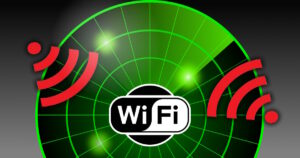 A company in Taiwan recently presented a developing WiFi tech that can be used to monitor your location, heart rate, breathing patterns, sleep cycles, and much more.
A company in Taiwan recently presented a developing WiFi tech that can be used to monitor your location, heart rate, breathing patterns, sleep cycles, and much more.
The company’s techie bossman, Doctor Tzi-cker Chiueh, claimed that, “Channel state in modern Wi-Fi is susceptible to minor environmental changes.” These tiny changes can be used with an algorithm he helped create that can do breathing rate estimation at 95 percent accuracy over 5 meters, and heart rate measurements at 83 accuracy at a 1 meter distance.
As it turns out, using WiFi sort of like radar is nothing new; it’s been around for a number of years now.
But there are two little details that nobody is mentioning which could make this “WiFi Sensing” much, much more common in the years to come…
Nothing new under the sun?
The observant reader will no doubt remember Popular Mechanics’ story from a few years ago:
Scientists Can Now Use WiFi to See Through People’s Walls
The PM articles talks about how researchers at Carnegie Mellon University can map human bodies through walls using WiFi signals.
It’s kind of like a very basic type of radar, only the radio waves are emitted by your WiFi, and detected/processed by the spy’s equipment. Other research in this area used similar signals emitted by smartphones and tablets.
Ta-DA! Basic position and movement of people inside many buildings can be viewed from the outside.
How it works
The key to making WiFi Sensing work is something called “channel state information”.
Modern WiFi (amongst other tech) uses channel state information to communicate what’s happening with the radio signals bouncing around between the transmitter and receiver.
So, for example, your WiFi router sends data in the form of radio waves to your laptop. Your laptop reports back the quality of the received signal on a given channel. It tells the router about things like signal power levels, fading, and scattering.
This is especially important in modern systems that use multiple antennas to send/receive WiFi. Multiple signals are beamed out of the router, but then they bounce around before they hit your lappy. Some of the signals will arrive before/after others, some signals will be weaker or stronger, and the signals may interact with each other in fun ways.
So, channel state allows your laptop to communicate back to the router what’s happening with those signals in more or less real-time. The router then adjusts the signals it transmits so that you get a better connection. Nifty!
As it happens, with the right processing of this channel state info, you can tell if there’s a person walking between the two devices, or whatever – just like a radar image. And if your algorithm is good enough and the signals are clean enough, you can even detect the movement of a person’s chest as they breathe. Yikes!
Well, but it’s not that accurate, right?
It’s obviously better than most of us thought. Still, there are only a few applications of the tech currently on the market. For example, Google Nest can apparently detect your breathing patterns already (albeit using millimeter waves).
But all of this is about to change according to MIT Technology Review:
Since 2020, the 802.11bf Task Group for WLAN Sensing, led by experts from companies like Huawei and Qualcomm, has been working on standards for chipmakers designed to make Wi-Fi sensing easier. Crucially, when the new standards go into effect, the channel state information that Wi-Fi sensing algorithms use will become more consistent. Right now, that information requires lots of qualifying and debugging. When the new standard comes out in 2025, it will allow “every Wi-Fi device to easily and reliably extract the signal measurements,” Yang says. That alone should help get more Wi-Fi sensing products on the market. “It will be explosive,” Liu believes.
Another change is the introduction of WiFi 7. New bands added to WiFi mean even more channel state information, and therefore even more improved accuracy.
WiFi 7 also adds support for more tiny antennas on each WiFi device, which should make triangulating positions of people and objects even more accurate.
You can bet Big Data will be ALL OVER this one
 If you think your phone listening for keywords and then showing you ads for those products is creepy, get ready…
If you think your phone listening for keywords and then showing you ads for those products is creepy, get ready…
When your wireless tech is physically scanning everything you do, the possibilities become quite bonkers.
With smartphones and WiFi everywhere generating a constant wireless fog, plus more standardized channel state information, the data mining will no doubt be off the charts.
If Google is already using millimeter waves to detect your breathing, then you should definitely keep an eye out for “Android Radar” or some other such nonsense.
Of course, they won’t market it to you as, “We’re spying on you”, but you are still the product.
Just one more reason to go wired – and put your phone in airplane mode (or turn it off) when you don’t need it!





Wow that’s much worse than I thought.
It would cost too much for big brother to install this level of spying in every home but by including the tech in cool consumer devices, we pay for it and install it in our homes ourselves.
I’ve seen the name “Windows 11 Recall” pop up recently which seems like a security & privacy nightmare.
Can this be slowed or eliminated by hard wiring our house?
Yup. No wireless signals, no “radar”.
Of course, your neighbors might have WiFi, but the fewer active transmitters around you, the more difficult tracking becomes.